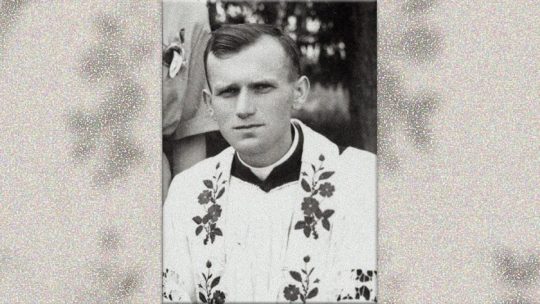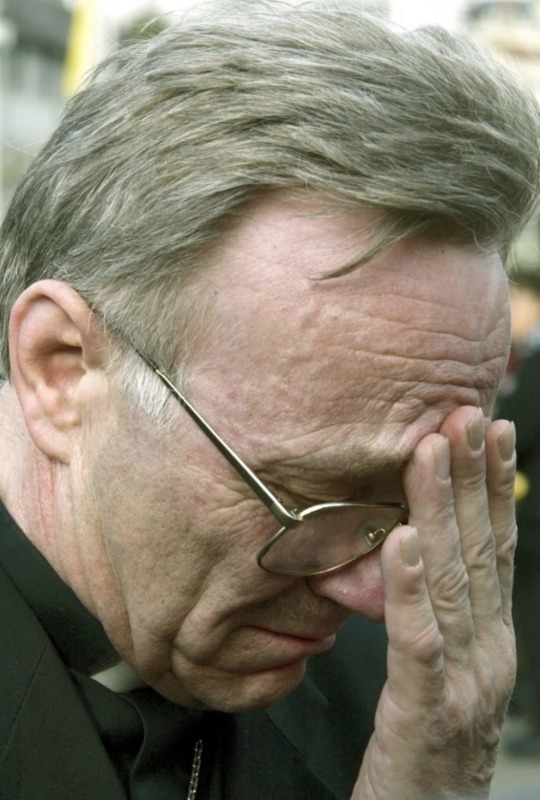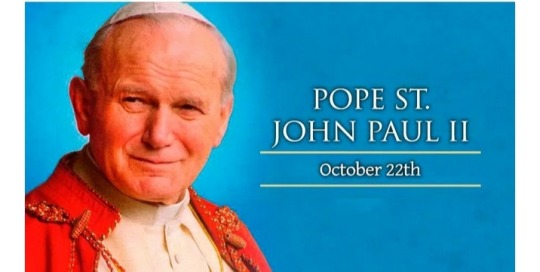#karol wojtyla
Text

Pope St John Paul ll in Ghana 🇬🇭
#catholic#religion#religous#catholiscism#christianity#catholicism#pope john paul ii#karol wojtyla#faith#faithful
64 notes
·
View notes
Text
“Pues mis sentidos se alimentaban, a cada paso, / del encanto de las mujeres que se cruzaban conmigo. / En varias ocasiones traté de seguirlas, / y me encontré con islas deshabitadas.
Pensé entonces que la belleza accesible a los sentidos / puede convertirse en un don difícil y peligroso; / sé de personas que por su causa dañan a otras / —así, lentamente, aprendí a valorar la belleza / accesible al espíritu, es decir, la verdad”.
— El taller del orfebre
2 notes
·
View notes
Text
SAINT OF THE DAY (October 5)

On October 5, the church celebrates the Memorial of St. Mary Faustina Kowalska, virgin.
St. Faustina was born Helena Kowalska on 25 August 1905 to a poor but devout Polish family in 1905.
At the age of 20, with very little education, and having been rejected from several other convents because of her poverty and lack of education, Helen entered the Congregation of the Sisters of Our Lady of Mercy.
There, she took the name Sr. Faustina and spent time in convents in both Poland and Lithuania.
Throughout her life, Jesus appeared to Sr. Faustina.
He asked her to become an apostle and secretary of his mercy, by writing down his messages of Divine Mercy for the world in her diary.
Jesus also asked Sr. Faustina to have an image painted of his Divine Mercy, with red and white rays issuing from his heart, and to spread devotion to the Divine Mercy novena.
Even before her death on 5 October 1938, devotion to Divine Mercy began to spread throughout Poland.
This little nun and Jesus’ message of Divine Mercy impacted Karol Wojtyla greatly, which became obvious to the world when he was elected Pope.
“It is truly marvelous how her devotion to the merciful Jesus is spreading in our contemporary world and gaining so many human hearts! This is doubtlessly a sign of the times — a sign of our twentieth century.
The balance of this century, which is now ending, in addition to the advances which have often surpassed those of preceding eras, presents a deep restlessness and fear of the future.
Where, if not in the Divine Mercy, can the world find refuge and the light of hope? Believers understand that perfectly,” Pope St. John Paul II wrote.
On 30 April 2000, Pope John Paul II canonized St. Faustina in what he was widely reported as saying was “the happiest day of my life.”
“Today, my joy is truly great in presenting the life and witness of Sr. Faustina Kowalska to the whole Church as a gift of God for our time.
By divine Providence, the life of this humble daughter of Poland was completely linked with the history of the 20th century, the century we have just left behind.
In fact, it was between the First and Second World Wars that Christ entrusted his message of mercy to her. Those who remember, who were witnesses and participants in the events of those years and the horrible sufferings they caused for millions of people, know well how necessary was the message of mercy,” the Pope said in his homily that day.
It was also on this day, the Sunday after Easter, that Pope John Paul II instituted the Feast of Divine Mercy, which Jesus had asked for in his messages to Sr. Faustina.
#Saint of the Day#St. Mary Faustina Kowalska#Congregation of the Sisters of Our Lady of Mercy#Divine Mercy#Karol Wojtyla#Pope John Paul II#Feast of Divine Mercy
22 notes
·
View notes
Text
Amore e responsabilità, la lezione di Wojtyła
Amore e responsabilità, la lezione di Wojtyła
Durante gli anni del corso di etica sessuale a Lublino, Karol Wojtyła scrisse il saggio Amore e responsabilità, coinvolgendo coppie di sposi e fidanzati. Nel testo, il futuro Giovanni Paolo II illustra perché utilitarismo e comandamento dell’amore siano in contrasto. E prende le mosse dal concetto di “persona” per spiegare cosa significhi davvero il dono di sé.
(more…)

View On WordPress
2 notes
·
View notes
Text
se cumplen 102 años del nacimiento de San Juan Pablo II.
se cumplen 102 años del nacimiento de San Juan Pablo II.
karol Wojtyła nació en Wadowice, en el sur de Polonia , un 18 de mayo de 1920
(more…)

View On WordPress
#El papa Juan Pablo II#Juan Pablo II#Karol Wojtyla#obispo de Roma#papa Juan Pablo II#primer Papa polaco#San Juan Pablo II#unpasoaldia
2 notes
·
View notes
Text

São João Paulo II, rogai por nós!
🇻🇦💛🇧🇷💚
By Milena Mariae.
#catholic saints#catholic church#tradition#life of the saints#pray for us#st john paul ii#karol wojtyla#jesus#catholic
0 notes
Text
Ceccano, a San Giovanni la reliquia di Giovanni Paolo II
La preziosa collezione di reliquie della Collegiata di S. Giovanni Battista a Ceccano si è arricchita di un’altra significativa testimonianza di fede. L’arciprete don Tonino Antonetti, al termine della messa di oggi, domenica 16 aprile, ha infatti benedetto la comunità con la reliquia di S. Giovanni Paolo II, che è arrivata a Ceccano proprio nella festa della Divina Misericordia, tanto cara a…

View On WordPress
0 notes
Text
“The attitude of solidarity is, so to speak, the natural consequence of the fact that human beings live and work together; it is the attitude of a community, in which the common good properly conditions and initiates participation and participation in turn properly serves the common good, fosters it, and furthers its realization. Solidarity signifies a constant readiness to accept and to realize one��s share in the community—what is one’s share because of one’s membership in a particular community.”
- Karol Wojtyla, The Acting Person
0 notes
Text
Anche in Polonia, la chiesa cattolica apre un'indagine (interna) sui casi di abusi sessuali commessi da preti. La decisione arriva dopo l’inchiesta giornalistica che contesta all’allora arcivescovo di Cracovia Karol Wojtyla di aver taciuto.

0 notes
Text



Mgr Jacques Perrier, Bishop of Lourdes, held back his tears on April 01, 2005, after giving a press conference in Lourdes, where Pope John Paul ll made his last trip and pilgrimage abroad.
John Paul ll‘s state of health deteriorated sharply in the early morning
#catholic#religion#religous#faith#vatican#vatikan#christianity#faithful#pope john paul ii#karol wojtyla#catholiscism#Catholicism
20 notes
·
View notes
Text
Shockingly, almost every participant in the march who agreed to talk to us admitted that he did not watch the latest TVN 24 reportage titled "Franciszkańska 3", so he does not know the facts presented there from the period when Karol Wojtyła was still a Krakow metropolitan. Thus, these people protested against something they did not really know.
Where the fuck do I live...😵💫
#😳#tylu starszych ludzi naraz straciło kontakt z rzeczywistością a tymczasem psychiatria w polsce w zapaści...#onet#franciszkańska 3#tvn24#jan paweł ii#john paul ii#karol wojtyla#only hope these are only old people
1 note
·
View note
Text
Polonia: arriva uno tsunami di fango "rosso" contro Giovanni Paolo II

View On WordPress
#cardinal Sapieha#dossier comunista#Giovanni Paolo II#Karol Wojtyla#monsignor Jan Machniak#Polonia#tsunami#Wlodzimierz Redzioch
0 notes
Text
«Vi spiego l’influenza di san Giovanni della Croce su Wojtyła»
«Il lavoro giovanile di Karol Wojtyła sulle opere di san Giovanni della Croce durò circa otto anni», e culminò nella tesi di dottorato dedicata alla dottrina della fede nel santo spagnolo. La Bussola intervista don Andrzej Dobrzyński.
Continue reading Untitled

View On WordPress
#Dottore della Chiesa#Giovanni Paolo II#Karol Wojtyla#San Giovanni della Croce#santi carmelitani#santi e beati
0 notes
Text
SAINT OF THE DAY (October 22)

Saint John Paul II is perhaps one of the most well-known pontiffs in recent history.
He is most remembered for his charismatic nature, his love of youth and his world travels, along with his role in the fall of communism in Europe during his 27-year papacy.
Karol Józef Wojtyla, known as John Paul II since his October 1978 election to the papacy, was born in the Polish town of Wadowice, a small city 50 kilometers from Krakow, on 18 May 1920.
He was the youngest of three children born to Karol Wojtyla and Emilia Kaczorowska.
His mother died in 1929. His eldest brother Edmund, a doctor, died in 1932. His father, a non-commissioned army officer, died in 1941. A sister, Olga, had died before he was born.
He was baptized on 20 June 1920 in the parish church of Wadowice by Fr. Franciszek Zak, made his First Holy Communion at age 9, and was confirmed at 18.
Upon graduation from Marcin Wadowita high school in Wadowice, he enrolled in Krakow's Jagiellonian University in 1938.
The Nazi occupation forces closed the university in 1939 and young Karol had to work in a quarry (1940-1944).
He then worked in the Solvay chemical factory to earn his living and to avoid being deported to Germany.
In 1942, aware of his call to the priesthood, he began courses in the clandestine seminary of Krakow, run by Cardinal Adam Stefan Sapieha, archbishop of Krakow.
At the same time, Karol Wojtyla was one of the pioneers of the "Rhapsodic Theatre," also clandestine.
After the Second World War, he continued his studies in the major seminary of Krakow, once it had re-opened, and in the faculty of theology of the Jagiellonian University.
He was ordained to the priesthood by Archbishop Sapieha in Krakow on 1 November 1946.
Shortly afterwards, Cardinal Sapieha sent him to Rome where he worked under the guidance of the French Dominican, Garrigou-Lagrange.
He finished his doctorate in theology in 1948 with a thesis on the subject of faith in the works of St. John of the Cross (Doctrina de fide apud Sanctum Ioannem a Cruce).
At that time, during his vacations, he exercised his pastoral ministry among the Polish immigrants of France, Belgium and Holland.
In 1948, he returned to Poland and was vicar of various parishes in Krakow as well as chaplain to university students.
This period lasted until 1951 when he again took up his studies in philosophy and theology.
In 1953, he defended a thesis on the "Evaluation of the possibility of founding a Catholic ethic on the ethical system of Max Scheler" at Lublin Catholic University.
He became professor of moral theology and social ethics in the major seminary of Krakow and in the Faculty of Theology of Lublin.
On 4 July 1958, he was appointed titular bishop of Ombi and auxiliary of Krakow by Pope Pius XII.
He was consecrated by Archbishop Eugeniusz Baziak on 28 September 1958 in Wawel Cathedral, Krakow.
On 13 January 1964, he was appointed archbishop of Krakow by Pope Paul VI, who made him a cardinal on 26 June 1967 with the title of S. Cesareo in Palatio of the order of deacons, later elevated pro illa vice to the order of priests.
Besides taking part in Vatican Council II (1962-1965) where he made an important contribution to drafting the Constitution Gaudium et spes, Cardinal Wojtyla participated in all the assemblies of the Synod of Bishops.
The Cardinals elected him Pope at the Conclave of 16 October 1978. He took the name of John Paul II.
On October 22, the Lord's Day, he solemnly inaugurated his Petrine ministry as the 263rd successor to the Apostle.
His pontificate, one of the longest in the history of the Church, lasted nearly 27 years.
Driven by his pastoral solicitude for all Churches and by a sense of openness and charity to the entire human race, John Paul II exercised the Petrine ministry with a tireless missionary spirit, dedicating it all his energy.
He made 104 pastoral visits outside Italy and 146 within Italy. As Bishop of Rome, he visited 317 of the city's 333 parishes.
He had more meetings than any of his predecessors with the People of God and the leaders of Nations.
More than 17,600,000 pilgrims participated in the General Audiences held on Wednesdays (more than 1160), not counting other special audiences and religious ceremonies [more than 8 million pilgrims during the Great Jubilee of the Year 2000 alone], and the millions of faithful he met during pastoral visits in Italy and throughout the world.
We must also remember the numerous government personalities he encountered during 38 official visits, 738 audiences and meetings held with Heads of State, and 246 audiences and meetings with Prime Ministers.
His love for young people brought him to establish the World Youth Days.
The 19 WYDs celebrated during his pontificate brought together millions of young people from all over the world.
At the same time, his care for the family was expressed in the World Meetings of Families, which he initiated in 1994.
John Paul II successfully encouraged dialogue with the Jews and with the representatives of other religions, whom he invited several times to prayer meetings for peace, especially in Assisi.
Under his guidance, the Church prepared herself for the third millennium and celebrated the Great Jubilee of the Year 2000 in accordance with the instructions given in the Apostolic Letter Tertio Millennio adveniente.
The Church then faced the new epoch, receiving his instructions in the Apostolic Letter Novo Millennio ineunte in which he indicated to the faithful their future path.
With the Year of the Redemption, the Marian Year and the Year of the Eucharist, he promoted the spiritual renewal of the Church.
He gave an extraordinary impetus to Canonizations and Beatifications, focusing on countless examples of holiness as an incentive for the people of our time.
He celebrated 147 beatification ceremonies during which he proclaimed 1,338 Blesseds and 51 canonizations for a total of 482 saints.
He made Thérèse of the Child Jesus a Doctor of the Church.
He considerably expanded the College of Cardinals, creating 231 Cardinals (plus one in pectore) in 9 consistories.
He also called six full meetings of the College of Cardinals.
He organized 15 Assemblies of the Synod of Bishops — six Ordinary General Assemblies (1980, 1983, 1987, 1990, 1994, and 2001); one Extraordinary General Assembly (1985); and eight Special Assemblies (1980,1991, 1994, 1995, 1997, 1998 (2), and 1999).
His most important Documents include 14 Encyclicals, 15 Apostolic Exhortations, 11 Apostolic Constitutions, 45 Apostolic Letters.
He promulgated the Catechism of the Catholic Church in the light of Tradition as authoritatively interpreted by the Second Vatican Council.
He also reformed the Eastern and Western Codes of Canon Law, created new Institutions, and reorganized the Roman Curia.
As a private Doctor, he also published five books of his own: "Crossing the Threshold of Hope" (October 1994), "Gift and Mystery, on the fiftieth anniversary of my ordination as priest" (November 1996), "Roman Triptych" poetic meditations (March 2003), "Arise, Let us Be Going" (May 2004) and "Memory and Identity" (February 2005).
In the light of Christ risen from the dead, on 2 April A.D. 2005, at 9:37 pm, while Saturday was drawing to a close and the Lord's Day was already beginning, the Octave of Easter and Divine Mercy Sunday, the Church's beloved Pastor, John Paul II, departed this world for the Father.
From that evening until April 8, date of the funeral of the late Pontiff, more than three million pilgrims came to Rome to pay homage to the mortal remains of the Pope.
Some of them queued up to 24 hours to enter St. Peter's Basilica.
On April 28, the Holy Father Benedict XVI announced that the normal five-year waiting period before beginning the cause of beatification and canonization would be waived for John Paul II.
The cause was officially opened by Cardinal Camillo Ruini, vicar general for the diocese of Rome, on 28 June 2005. He was beatified on 1 May 2011.
On 27 April 2014, he was canonized by Pope Francis during a ceremony in St. Peter's Square.
In an April 24 message sent to the Church in Poland, Pope Francis gave thanks for the 'great gift' of the new Saint, saying of John Paul II that he is grateful, "as all the members of the people of God, for his untiring service, his spiritual guidance, and for his extraordinary testimony of holiness."
#Saint of the Day#Saint John Paul II#Pope John Paul II#Karol Józef Wojtyla#World Youth Day#World Meetings of Families#Great Jubilee of the Year 2000#College of Cardinals
10 notes
·
View notes
Text
Padre Pio Stigmata, Miracle Worker or Fraud - Historic Mysteries
Padre Pio Stigmata, Miracle Worker or Fraud – Historic Mysteries
https://www.historicmysteries.com/padre-pio-stigmata/

View On WordPress
#1934#1947#1962#20 September 1918#23 September 1968#25 May 1887#Beautification#Catholic#Catholic Church#Catholicism#Christian#Christianity#Consiglia De Martino#Dr. Wanda Poltawska#Eucharist#Father Karol Jozef Wojtyla#Francesco Forgione#Gemma de Giorgi#Guardian Angel#Holy See#Italy#Jesus#October 1996#Padro Pio#Pietrelcina#Pope John Paul II#Priest#Saint#Stigmata#Vatican
3 notes
·
View notes
